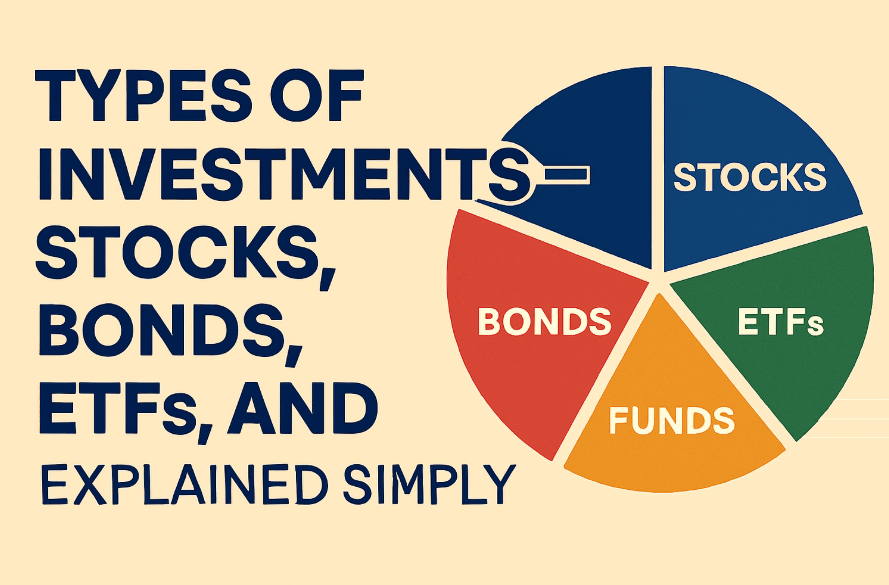- Live Life Grow Wealth
- Posts
- 📈Series 1 Day 4: Types of Investments – Stocks, Bonds, ETFs, and Funds Explained Simply
📈Series 1 Day 4: Types of Investments – Stocks, Bonds, ETFs, and Funds Explained Simply

Today’s Headline
📈 Series 1: Investing Foundations (Beginner-Friendly)
📈 Day 4: Types of Investments – Stocks, Bonds, ETFs, and Funds Explained Simply
When I first started learning about investing, I felt like I had just walked into a foreign country where everyone was speaking a language I couldn’t understand. Words like stocks, bonds, ETFs, and funds were thrown around as if everyone was born knowing them. Truth be told, I wasn’t. And I’m guessing some of you feel the same way.
So today, I want to break things down for you in plain, simple English. No complicated jargon. No textbook definitions. Just real explanations you can understand, even if you’ve never invested a dollar before.
Think of this as me sitting down with you over coffee, sharing the basics in a way that finally clicks. By the end, you’ll know the difference between the most common types of investments—and which ones might make sense for you.
If you're looking to grow your portfolio with experienced guidance and institutions you can trust, take a look at Fisher Investments — they’ve built their reputation on aligning strategy with goals, not selling hype.
7 Ways to Take Control of Your Legacy
Planning your estate might not sound like the most exciting thing on your to-do list, but trust us, it’s worth it. And with The Investor’s Guide to Estate Planning, preparing isn’t as daunting as it may seem.
Inside, you’ll find {straightforward advice} on tackling key documents to clearly spell out your wishes.
Plus, there’s help for having those all-important family conversations about your financial legacy to make sure everyone’s on the same page (and avoid negative future surprises).
Why leave things to chance when you can take control? Explore ways to start, review or refine your estate plan today with The Investor’s Guide to Estate Planning.
Why It Matters to Know the Types of Investments
Here’s the thing: when people say “I’m investing,” they don’t all mean the same thing. Some are buying stocks. Others are putting money into bonds. Some prefer ETFs or mutual funds because they don’t want to pick investments one by one.
If you don’t know what these terms mean, you might get lost in conversations or worse, end up putting your money somewhere without fully understanding it. And trust me—that’s a dangerous move.
So let’s keep it simple. Let me show you the building blocks of the investing world.
🟢 Stocks: Owning a Piece of a Company
When you buy a stock, you’re basically buying a piece of a company. It’s like owning a slice of pizza. The whole pizza is the company, and your slice is your share.
If the company does well, the value of your slice goes up.
If the company struggles, the value of your slice goes down.
Simple, right?
Let’s say you buy one share of Apple. That means you’re technically a part-owner of Apple. Of course, you don’t get to walk into their office and make decisions—but you do benefit if Apple grows and makes profits.
Why people love stocks:
They have the potential for high returns.
Some companies pay dividends (small cash payments) to shareholders.
They’re easy to buy and sell on stock exchanges.
The risk: Stocks can be very volatile. Prices go up and down every day. If you can’t handle seeing your money drop in the short term, stocks can feel scary.
🔵 Bonds: Lending Your Money
If stocks are about owning, bonds are about lending.
When you buy a bond, you’re basically lending your money to a company or government. In return, they promise to pay you back later, plus some interest.
Think of it like this: if your friend borrows $100 and promises to return $110 in a year, you just made a little bond deal.
Why people like bonds:
They are generally safer than stocks.
You earn interest, which is steady income.
Governments and big companies issue bonds, so they’re usually trustworthy.
The risk: Bonds don’t usually give you huge profits. If you’re looking to grow your money fast, bonds alone won’t get you there. Also, if interest rates go up, the value of old bonds can drop.
🟣 ETFs: The Basket of Investments
Now let’s talk about ETFs, which stand for Exchange-Traded Funds. Don’t let the long name scare you—it’s actually simple.
Imagine walking into a fruit market. Instead of buying just one apple (a stock) or lending your money to the seller (a bond), you buy a basket filled with different fruits—apples, oranges, bananas. That basket is an ETF.
ETFs let you invest in many stocks or bonds at once, all in a single purchase. For example:
One ETF might hold the biggest 500 companies in the U.S. (S&P 500).
Another ETF might focus on technology stocks.
Another could even focus on bonds.
Why people like ETFs:
Instant diversification—you don’t have to pick just one stock.
They’re usually low-cost compared to traditional funds.
Easy to trade, just like stocks.
The risk: If the whole market drops, your ETF will also drop, even though it’s diversified. It won’t save you from all losses.
🟠 Mutual Funds: The Managed Version
Mutual funds are similar to ETFs but with one big difference: they’re managed by professionals.
When you put money into a mutual fund, you’re pooling your cash with other investors. A fund manager then decides which stocks, bonds, or assets to buy. You don’t have to choose—the manager does it for you.
Why people like mutual funds:
You don’t need to research or pick investments.
Some funds are tailored for specific goals (like retirement).
Great for people who want a hands-off approach.
The risk:
Fees can be higher because managers need to get paid.
Not all managers beat the market (in fact, many don’t).
Less flexibility—you can’t trade them like stocks throughout the day.
⚖️ Comparing Them Side by Side
Let me summarize with a quick comparison so it really sticks:
Stocks = Owning part of a company. Higher risk, higher reward.
Bonds = Lending your money. Safer, but lower returns.
ETFs = A basket of investments you can trade easily. Diversified and low-cost.
Mutual Funds = A managed pool of investments. Less work for you, but higher fees.
Each one has its place, depending on your goals, timeline, and personality.
📊 How I Think About Using Them Together
Personally, I like to think of investments like ingredients in a recipe. You don’t want just one flavor—you want balance.
Stocks are like the spice—exciting but strong.
Bonds are like rice—stable and filling.
ETFs are like a combo meal—balanced and easy.
Mutual funds are like hiring a chef—you let someone else cook.
Depending on whether you’re young and just starting out, or closer to retirement, the mix of these investments will look different.
📝 Key Takeaways
Stocks give ownership and growth but can be bumpy.
Bonds offer steady income and safety but grow slowly.
ETFs are baskets that spread your risk across many investments.
Mutual funds are managed by experts, but you’ll pay more in fees.
Knowing the difference means you can make smarter choices with your money. Instead of blindly following what others say, you’ll understand what you’re putting your hard-earned cash into.
Final Takeaways
Here’s my honest advice: don’t overcomplicate it. Start small, stay consistent, and always know why you’re investing in something.
If you’re new, ETFs are often the easiest entry point. They give you instant diversification without requiring you to research dozens of companies. As you gain confidence, you can add individual stocks or bonds.
Most importantly, invest in a way that matches your risk tolerance and goals. Investing isn’t about copying others—it’s about building your path to financial freedom.
✅ Call to Action
Now that you understand the four main types of investments, I want you to take a small step today. Open your notes app, grab a piece of paper, or just think about this:
👉 Which type of investment feels most natural to you right now—stocks, bonds, ETFs, or mutual funds?
Write it down. That simple action will make you more aware of where you want to begin. Tomorrow, we’ll go even deeper into strategies you can use to mix and match these investments in a way that makes sense for you.
Your financial journey is just getting started—let’s keep building together.
[Live Life Grow Wealth]
🎓 Free Masterclasses to Unlock Your Investment Potential
Take your money skills to the next level with expert-led workshops designed to help you grow smarter and faster.

Recommendations Section
|
|
|
|
DISCLAIMER
I make no representations, warranties, or guarantees, whether expressed or implied, that the content provided is accurate, complete, or up-to-date. Past performance is not indicative nor a guarantee of future returns.
I am an individual content creator and not regulated or licensed by the Monetary Authority of Singapore (MAS) as I do not provide investment services.
All forms of investments carry risks, including the risk of losing your entire invested amount. Such activities may not be suitable for everyone. You are strongly encouraged to seek advice from a professional financial advisor if you have any doubts or concerns.








